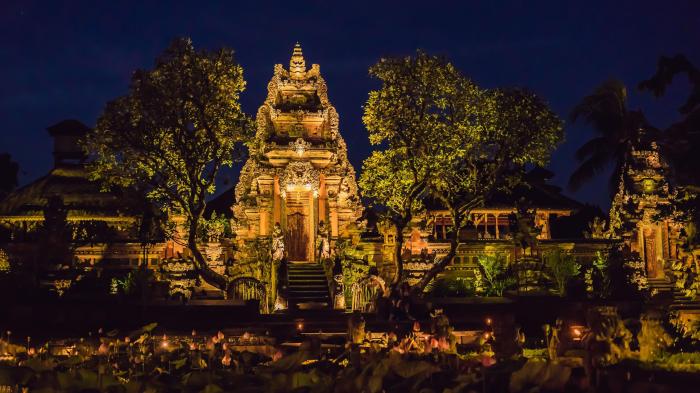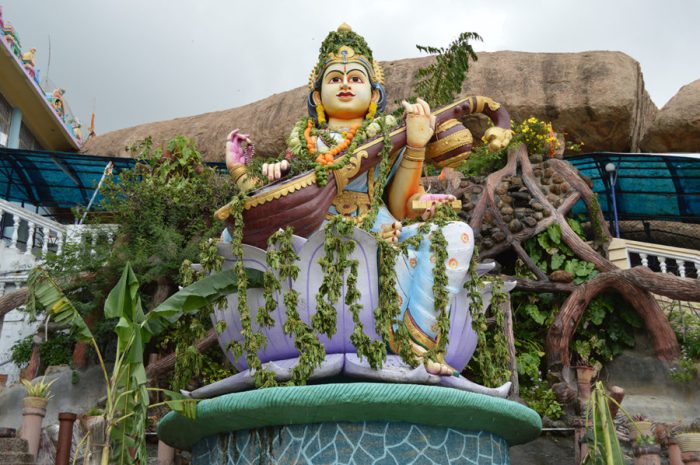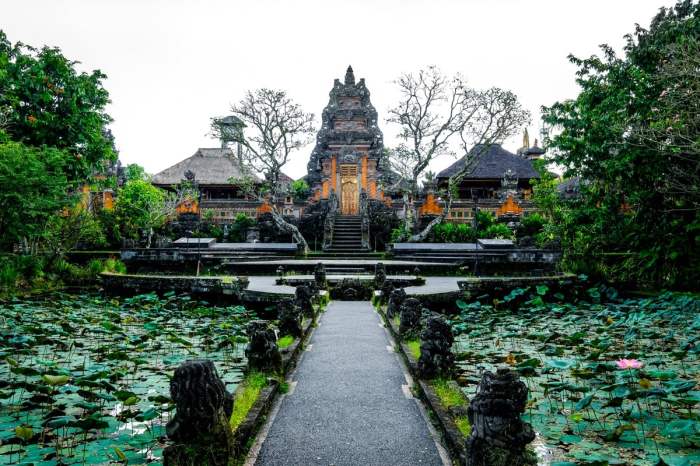Embark on a journey through the hallowed halls of Saraswati temples, architectural wonders that pay homage to the goddess of knowledge and the arts. These sacred spaces have played a pivotal role in shaping Indian culture, inspiring generations with their intricate designs and profound spiritual significance.
From ancient ruins to modern marvels, Saraswati temples stand as testaments to the enduring legacy of Hinduism. Their architectural diversity reflects the rich tapestry of Indian culture, showcasing a fusion of traditional styles and innovative interpretations.
Historical Significance

Saraswati temples hold immense historical significance in Hindu culture, dating back to ancient times. These sacred spaces are dedicated to the goddess Saraswati, the deity of knowledge, music, and the arts.
The earliest known Saraswati temples were built during the Vedic period (1500-500 BCE). One of the most notable examples is the Saraswati Temple in Pushkar, Rajasthan. This ancient temple, built in the 12th century CE, is renowned for its intricate architecture and beautiful sculptures depicting scenes from Hindu mythology.
Architectural Features
Saraswati temples typically exhibit unique architectural features that reflect the goddess’s association with knowledge and creativity. These features include:
- Open-air courtyards:To facilitate gatherings for religious ceremonies and discussions.
- Mandapas (halls):Dedicated to the performance of music and dance, symbolizing Saraswati’s patronage of the arts.
- Garbhagrihas (sanctums):Housing the main idol of Saraswati, often adorned with intricate carvings and sculptures.
- Shikharas (spires):Rising above the garbhagriha, representing the goddess’s connection to the divine realm.
Religious Importance

Saraswati temples hold immense religious significance as centers of worship for the goddess Saraswati, the Hindu deity of knowledge, music, arts, and eloquence. These temples serve as sacred spaces where devotees seek blessings and pay homage to the goddess.
Rituals and Ceremonies
Saraswati temples are associated with various rituals and ceremonies that honor the goddess and invoke her blessings. One of the most important rituals is the “Saraswati Puja,” which is typically performed during the festival of Vasant Panchami. During this puja, devotees offer prayers, flowers, and other offerings to the goddess.
Other rituals include the recitation of hymns, chanting of mantras, and the performance of classical music and dance.
Devotional Practices
Devotees visit Saraswati temples throughout the year to offer prayers and seek the goddess’s favor. They may bring offerings such as flowers, fruits, and incense, and light lamps in her honor. Some devotees also observe fasts or perform special austerities to show their devotion to Saraswati.
Architectural Design: Saraswati Temple

Saraswati temples showcase a rich architectural heritage, exhibiting distinct design elements that embody the goddess’s essence and symbolize knowledge, wisdom, and creativity.The layout of Saraswati temples typically follows a traditional Hindu temple plan, featuring a sanctum sanctorum (garbhagriha) housing the deity’s idol, an antechamber (antarala), and a pillared hall (mandapa) for devotees.
The sanctum sanctorum is often adorned with intricate carvings and sculptures depicting scenes from Saraswati’s mythology, while the antechamber serves as a transition space between the sanctum and the mandapa.
Ornamentation
Saraswati temples are known for their exquisite ornamentation, which manifests in the intricate carvings and sculptures that adorn the temple walls, pillars, and ceilings. These carvings often depict scenes from Saraswati’s life and legends, as well as symbolic motifs representing knowledge, music, and the arts.
Located near the bustling Canggu Beach , the Saraswati Temple is a serene oasis dedicated to the Hindu goddess of knowledge and music. This sacred site features intricate carvings, lush gardens, and a tranquil atmosphere that invites contemplation and reflection.
Its proximity to Canggu Beach offers a unique opportunity to combine spiritual exploration with the vibrant coastal charm of Bali.
The temple interiors are adorned with vibrant paintings and murals, further enhancing the temple’s aesthetic appeal.
Symbolism
The architectural design of Saraswati temples incorporates numerous symbolic elements that reflect the goddess’s attributes and significance. For instance, the temple’s entrance gate is often designed as a “gopuram,” a towering structure that symbolizes the gateway to knowledge and wisdom.
The temple’s walls are often adorned with images of swans, Saraswati’s vahana (mount), representing purity and grace. The temple’s pillars are sometimes carved with images of books or writing implements, symbolizing the goddess’s association with education and the arts.
Architectural Styles
Saraswati temples across India exhibit a range of architectural styles, reflecting the diverse cultural and regional influences that have shaped their design. Some of the notable architectural styles include:
Nagara Style
This style is prevalent in North India and is characterized by tall, curvilinear spires known as “shikharas.” The temples feature intricate carvings and sculptures, and the interiors are often adorned with vibrant paintings.
Dravida Style
This style is common in South India and is known for its pyramidal towers known as “gopurams.” The temples are typically built on a raised platform and feature elaborate gateways and pillared halls.
Vesara Style
This style is a blend of the Nagara and Dravida styles and is found primarily in Central India. The temples exhibit a combination of curvilinear and pyramidal elements, creating a unique and harmonious architectural expression.
Cultural Influence

Saraswati temples hold a significant cultural influence in Indian society, fostering the values of education, music, and the arts.
As centers of learning, Saraswati temples have historically played a crucial role in promoting literacy and education. They often house libraries containing ancient texts and manuscripts, providing access to knowledge and preserving cultural heritage. The temple environment encourages contemplation, reflection, and the pursuit of wisdom.
Role in Education
- Saraswati temples are often associated with schools and educational institutions, symbolizing the importance of education in society.
- Students and scholars visit the temples to seek blessings for academic success and guidance in their studies.
- Temples organize educational programs, workshops, and seminars to promote knowledge sharing and cultural enrichment.
Role in Music and the Arts
Saraswati is also revered as the patron deity of music and the arts. Temples dedicated to her often feature performances of classical music, dance, and theater.
- Musicians and artists seek blessings at Saraswati temples to enhance their creativity and skill.
- Temples host concerts and exhibitions showcasing the talents of local artists and performers.
- The presence of Saraswati temples in a community encourages the preservation and传承 of traditional art forms.
Tourism and Pilgrimage

Saraswati temples are significant destinations for both tourism and pilgrimage. They attract visitors from around the world who come to experience the unique spiritual and cultural atmosphere of these temples.Pilgrims visit Saraswati temples to pay homage to the goddess Saraswati, who is revered as the patron of knowledge, music, and the arts.
They offer prayers, make offerings, and participate in religious ceremonies to seek her blessings. The temples are also popular with tourists who are interested in learning about Hindu culture and architecture.
Unique Experiences and Attractions
Saraswati temples offer a range of unique experiences and attractions for visitors. These include:
Beautiful architecture
Saraswati temples are often adorned with intricate carvings and sculptures that depict scenes from Hindu mythology. The temples are also known for their vibrant colors and colorful interiors.
Serene atmosphere
Saraswati temples are typically located in peaceful and tranquil settings. Visitors can come here to relax and meditate, or simply to enjoy the beauty of the surroundings.
Religious ceremonies
Saraswati temples host a variety of religious ceremonies throughout the year. These ceremonies are often accompanied by music and dance, and they offer visitors a chance to experience Hindu culture firsthand.
The Saraswati Temple, with its intricate carvings and serene ambiance, is a must-visit destination for any history enthusiast. While you’re in the area, why not explore other nearby attractions? Check out attractions near me to discover hidden gems and make the most of your trip.
Don’t miss the opportunity to immerse yourself in the rich cultural heritage of the region at the Saraswati Temple.
Educational opportunities
Saraswati temples often have libraries or museums that contain books and artifacts related to Hindu culture and religion. Visitors can come here to learn more about the goddess Saraswati and her significance in Hinduism.
Modern Interpretations

In contemporary society, Saraswati temples have undergone various interpretations and adaptations to reflect evolving societal values and artistic sensibilities. These modern approaches to temple architecture prioritize innovation, sustainability, and inclusivity while preserving the essence of traditional design.
Architects and designers have experimented with novel materials, such as glass, steel, and concrete, to create striking and contemporary temple structures. These materials allow for greater transparency, natural light, and a sense of openness. The incorporation of sustainable practices, including rainwater harvesting and energy-efficient lighting, reflects a growing awareness of environmental responsibility.
Saraswati Temple is a popular Hindu temple in Bali, known for its beautiful architecture and serene atmosphere. After visiting the temple, you may want to explore the nearby Jimbaran Bay, famous for its jimbaran seafood restaurants. Indulge in the fresh and flavorful seafood dishes while enjoying the stunning sunset views.
Afterward, you can return to Saraswati Temple for a peaceful evening stroll or meditation, soaking in the temple’s tranquil ambiance.
Inclusivity and Accessibility, Saraswati temple
Modern Saraswati temples prioritize inclusivity and accessibility, catering to the diverse needs of worshippers and visitors. Temples feature ramps and elevators for easy access, as well as designated spaces for individuals with disabilities. Additionally, many temples offer multi-lingual services and educational programs to accommodate a broader audience.
Comparative Analysis

Saraswati temples share similarities with other Hindu temples in terms of their architectural design, religious significance, and cultural impact. However, there are also some key differences that distinguish them from temples dedicated to other deities.
Architectural Design
- Similarities:Both Saraswati temples and other Hindu temples typically feature a sanctum sanctorum, where the deity’s idol is housed, and a mandapa, or hall, where devotees gather for worship.
- Differences:Saraswati temples often have a more elaborate mandapa than other temples, as this is where the goddess’s musical performances are said to take place. Additionally, Saraswati temples may feature a water tank or fountain, as water is associated with the goddess’s purity and knowledge.
Religious Significance
- Similarities:Saraswati temples are places of worship for Hindus who seek the goddess’s blessings for knowledge, wisdom, and the arts. Like other Hindu temples, they are also used for religious ceremonies and festivals.
- Differences:Saraswati temples are particularly popular among students and scholars, who pray to the goddess for success in their studies. Additionally, Saraswati is often invoked during the Hindu festival of Vasant Panchami, which celebrates the arrival of spring and the goddess’s birthday.
Cultural Impact
- Similarities:Saraswati temples are important cultural landmarks in many parts of India and the world. They are often visited by tourists and pilgrims alike, and they play a significant role in the local community.
- Differences:Saraswati temples are particularly popular among musicians and artists, who often visit the temples to seek the goddess’s inspiration. Additionally, Saraswati temples are often used for educational purposes, as they are seen as places where knowledge and wisdom can be acquired.
Artistic Representations
Saraswati temples have been depicted in various art forms throughout history, showcasing the reverence and cultural significance associated with the goddess of knowledge and arts. These artistic representations encompass paintings, sculptures, and photography, each conveying unique interpretations and symbolism.
In paintings, Saraswati is often portrayed as a graceful and serene figure seated on a lotus flower, symbolizing purity and spiritual awakening. She is typically depicted with four arms, each holding a specific object: a book or scroll representing knowledge, a vina or musical instrument representing art, a rosary symbolizing meditation, and a water pot signifying the flow of knowledge and creativity.
Sculptures
Sculptures of Saraswati temples capture the essence of the goddess’s divine presence. These intricate carvings depict her in various poses, including seated, standing, or playing the vina. The sculptures often showcase exquisite detailing, capturing the goddess’s graceful features, elaborate ornaments, and flowing garments.
The use of materials such as marble, sandstone, or bronze adds to the sculptures’ aesthetic appeal and durability.
Photography
Photography has played a significant role in capturing the beauty and grandeur of Saraswati temples. Photographs document the architectural details, intricate carvings, and vibrant colors that adorn these sacred spaces. Through the lens of a camera, devotees and visitors can share and appreciate the artistic and spiritual essence of these temples, fostering a deeper connection with the goddess and her divine attributes.
Sacred Geography

Saraswati temples are found throughout India and beyond, reflecting the goddess’s widespread reverence. The geographical distribution of these temples provides insights into the factors that influenced their location and placement.
The presence of water bodies, particularly rivers and lakes, played a significant role in determining the location of Saraswati temples. As the goddess of knowledge, music, and art, Saraswati is associated with the flow of knowledge and creativity, symbolized by water.
Many temples are situated near or on the banks of rivers, such as the Saraswati River in Haryana and the Kaveri River in Karnataka.
Influence of Religious Beliefs
Religious beliefs and legends also influenced the placement of Saraswati temples. In some regions, temples are located at sites believed to be associated with the goddess’s manifestations or miracles. For instance, the Saraswati Temple in Thanjavur, Tamil Nadu, is said to have been built at the spot where the goddess appeared to the sage Agastya.
Influence of Cultural and Political Factors
Cultural and political factors also played a role in the distribution of Saraswati temples. In areas where the goddess was particularly revered, such as Bengal and Kerala, there is a higher concentration of temples dedicated to her. Additionally, the patronage of rulers and wealthy individuals contributed to the establishment of Saraswati temples in prominent locations.
Future Prospects

As we move forward into the 21st century, Saraswati temples face both opportunities and challenges. Their continued cultural significance, architectural innovation, and tourism growth will depend on a variety of factors.
One of the most important challenges facing Saraswati temples is the need to adapt to changing demographics and religious practices. In many parts of the world, traditional religious beliefs and practices are declining, and this is having an impact on the number of people who visit and support Saraswati temples.
Potential for Continued Cultural Significance
Despite these challenges, there is also a great deal of potential for Saraswati temples to continue to play an important role in the cultural and religious life of Hindus. These temples are not only places of worship but also centers of learning and community.
They offer a variety of programs and services, including religious instruction, music and dance classes, and social events.
Architectural Innovation
Another area of potential growth for Saraswati temples is in the area of architectural innovation. As new technologies and materials become available, architects are designing new temples that are more beautiful, sustainable, and accessible than ever before.
Tourism Growth
Finally, there is also a great deal of potential for tourism growth at Saraswati temples. These temples are often located in beautiful and historic settings, and they offer a unique glimpse into Hindu culture and religion. As more and more people travel to India and other parts of the world, Saraswati temples are likely to become increasingly popular tourist destinations.
Wrap-Up

As we conclude our exploration of Saraswati temples, it is evident that these sacred spaces continue to captivate and inspire. Their enduring legacy lies in their ability to foster knowledge, creativity, and spiritual growth. Whether as destinations for pilgrimage or centers of artistic expression, Saraswati temples remain vibrant symbols of Indian culture, preserving the wisdom and beauty of the past while embracing the possibilities of the future.
FAQs
What is the historical significance of Saraswati temples?
Saraswati temples have been revered since ancient times as centers of learning and worship for the goddess Saraswati. They have played a crucial role in preserving and transmitting knowledge, fostering education, and promoting the arts.
What are the architectural features of Saraswati temples?
Saraswati temples typically feature intricate carvings, sculptures, and ornamentation depicting scenes from Hindu mythology and the life of the goddess Saraswati. They often have multiple shrines, a stepped roof, and a central mandapa or hall for gatherings and rituals.
What is the religious importance of Saraswati temples?
Saraswati temples are dedicated to the goddess Saraswati, who is revered as the patron of knowledge, music, and the arts. Devotees visit these temples to seek blessings for success in education, creative pursuits, and spiritual growth.